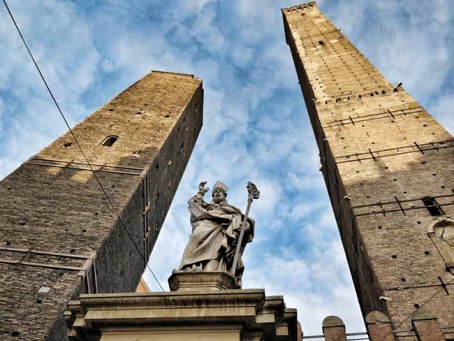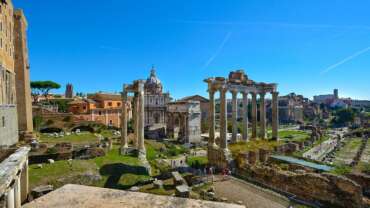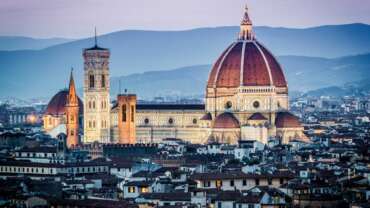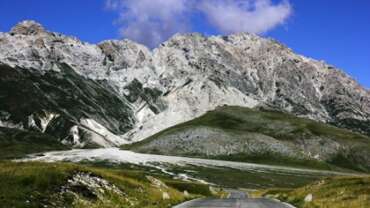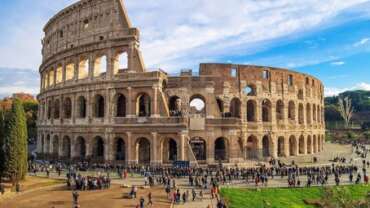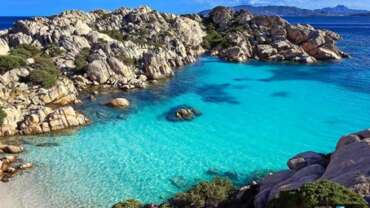North Italy
Emilia Romagna – is a medieval village, taverns under the arcades where you can enjoy authentic cuisine
Territory of Emilia Romagna
The territory of Emilia Romagna is divided almost symmetrically between the flat part, which covers about half of the territory and which coincides with the central-southern area of the Po Valley, and a part of the hills and mountains. The division between these two halves of territory coincides almost perfectly with the Via Emilia, a north-west/south-east route that goes from Rimini to Piacenza. The eastern part, that of Romagna, overlooks the Adriatic Sea with wide and sandy coasts that are well suited to seaside tourism.
Useful information about Emilia Romagna
Emilia Romagna is a region of northern Italy with the capital Bologna, composed of the union of two historical regions: Emilia, which includes the provinces of Piacenza, Parma, Reggio Emilia, Modena, Ferrara and most of the metropolitan city of Bologna, and Romagna, which includes the provinces of Ravenna, Forlì-Cesena, Rimini and the municipalities of the metropolitan city of Bologna located east of the river Sillaro (Dozza, Imola, Mordano, Casalfiumanese, Borgo Tossignano, Fontanelice, Castel del Rio).
Art and culture of Emilia Romagna
Land of great writers, musicians and artists, art and culture of Emilia Romagna have had several illustrious moments. Like the rest of central Italy, Emilia Romagna also enjoyed great prestige during the period of Humanism and the Renaissance. This period is linked to the personality of Ludovico Ariosto, the famous Italian literary author of Orlando Furioso, but also that of artists such as Parmigianino and Correggio. The University of Bologna, around which great poets and writers such as Giosuè Carducci and Giovanni Pascoli have orbited, has had great weight in the development of the culture of the region and of all of Italy. Giovanni Pascoli was born and raised in the territory of Emilia Romagna, to which he has always been very attached and whose landscapes are an ideal setting for a large part of his poetic composition.
Food and flavours of Emilia Romagna
The Emilia-Romagna cuisine is considered among the best in Italy so food and flavors of Emilia Romagna are famous throughout Italy and have often spread over national borders. First courses are absolutely worth mentioning: Lasagne, Tortelli, Tortellini, cappelletti and tagliatelle are just some of the famous pasta shapes produced in the area and absolute protagonists of traditional recipes, among which the Bolognese ragout stands out. Emilia Romagna is also famous for the production of cheeses and cold cuts, in particular Parmigiano Reggiano, Prosciutto and mortadella are inevitably associated with this territory. Special mention should be made of piadina romagnola, a street food typical of the Emilia Romagna region.
Places and tours of Emilia Romagna
Discovering places and tours in Emilia Romagna is a very rich experience. Everywhere in the area you can come across spectacular monuments, evidence of the ancient glories of the history of Emilia Romagna: this is the case of the Castello Estense in Ferrara, of unique beauty, or the Torre degli Asinelli, symbol of the city of Bologna. And for those tourists who love nature, the territory offers a myriad of regional and national parks: the Stirone e Piacenzano Regional Park, established in 2011 by the union of the Stirone Regional Park and the Piacenziano Geological Nature Reserve, or the Po Delta Regional Park. Finally, the coast of Romagna, with its wide sandy beaches has been always suitable for seaside tourism, which is why it has become over the years a popular summer destination for both beaches and the great nightlife.
Friuli Venezia Giulia – is a small universe in which many different traditions come together
Territory of Friuli Venezia Giulia
The territory of Friuli Venezia Giulia can be divided into four natural regions: Alpine, hilly, flat and coastal. The mountainous part is articulated in the northern part of the region and boasts very high peaks between the Pre-Alps and the Carnic Alps (among these the highest peak in the region, Mount Coglians, stands out), and between the Pre-Alps and the Julian Alps. The mountainous part is furrowed by valleys in correspondence of watercourses such as the Tagliamento and the Fella. The coastal part is the one to the south-east and overlooks the Adriatic Sea.
Useful information about Friuli Venezia Giulia
Friuli Venezia Giulia is an autonomous Italian region with a special statute and consists of two historical regions: Friuli and Venezia Giulia. Friuli, the main and most internal part, includes the provinces of Udine and Gorizia. The other part, the smallest, is the part of Venezia Giulia annexed to Italy after the Second World War and consists of the provinces of Gorizia and Trieste.
Art and culture of Friuli Venezia Giulia
The art and culture of Friuli Venezia Giulia have been affected by its particular history, in particular by the events that have taken place since the second half of the 19th century. At that time, in fact, in a Trieste still belonging to the Austro-Hungarian Empire, Italo Svevo and Umberto Saba were born and lived, both of whom were among the greatest literates of contemporary Italy. Friulian art, too, very much contaminated with Central European art, was very successful in those years thanks to the work of artists such as Giuseppe Barison, Arturo Rietti, Gino Parin, Gino De Finetti, Guido Fulignot, Edoardo Del Neri, Ugo Carà, Carlo Sbisà, Federico Righi.
Food and flavours of Friuli Venezia Giulia
The food and flavours of Friuli Venezia Giulia are greatly influenced by the great cultural variety of the peoples who have inhabited the region, but also by the morphological structure of the region. The typical and most present recipes on Friulian tables are Frico, Brovada, Gubana and also Polenta. In Friuli, moreover, the famous San Daniele ham is produced, precisely in San Daniele del Friuli. The local cuisine also includes sea and lake fish recipes. In Friuli Venezia Giulia, moreover, trout farming is widespread, especially salmon trout, with a production that covers 40% of the national total. Among the alcoholic beverages, in addition to the great variety of wines, stands out the Grappa.
Places and tours of Friuli Venezia Giulia
The Friuli Venezia Giulia region has so much to offer tourists, both in terms of cultural tourism, both in terms of natural landscapes, so there are so many places and itineraries in Friuli Venezia Giulia that deserve to be visited. Starting from the must-see towns such as Trieste, with its marvellous Miramare Castle, Gorizia, a meeting point between East and West, but also Cividale del Friuli and Aquileia, both nominated by UNESCO as World Heritage Sites. As for the landscapes, the mountain ones are not to be missed, such as the Natural Park of the Friulian Dolomites, but there are also sea landscapes, such as the beautiful Lignano Sabbiadoro, a beautiful town overlooking the Adriatic Sea.
Liguria – is sweet colored hills, small fishing villages and beautiful seascapes
Territory of Liguria
The territory of Liguria is very small, even if densely inhabited. The region is between the Ligurian Alps and the Ligurian Apennines to the north and the Ligurian Sea to the south and forests cover 62.6% of the entire territory. The Ligurian Riviera, of which a good part is constituted by the Gulf of Genoa, alternates an area of rocky and jagged coasts (east coast) and one where these last ones alternate perfectly with sandy beaches (west coast).
Useful information about Liguria
The Liguria region is a region in the north-west of Italy. It is washed by the Ligurian Sea to the south, bordered by France to the west, Piedmont and Emilia-Romagna to the north and Tuscany to the south-east. The region is part of the Alps-Mediterranean Euroregion. The capital is Genoa, the other provinces are Imperia, La Spezia and Savona.
Art and culture of Liguria
Art and culture of Liguria are very much linked to its great maritime tradition, which has made it a cultural center for several centuries. This characteristic of its cultural pole brought in the Maritime Republic of Genoa the masters Paul Rubens and Antoon Van Dyck, pupil of the first. Their stay, together with that of Caravaggio, will give life to the Genoese Baroque, which had one of its greatest interpreters in Bernardo Strozzi.
Food and flavours of Liguria
Food and flavours of Liguria are those typical of the Mediterranean cuisine, which combines sea and land products enhanced by the herbs of the Mediterranean and other products such as the fine olive oil. The olives, in general, are very present in Ligurian cuisine, in particular the olives taggiasche, typical of the province of Imperia. Typical of Liguria is the pesto alla Genovese, a very famous sauce appreciated throughout Italy, obtained by pounding the basil, with oil and other ingredients, used particularly for trofie al pesto.
Places and tours of Liguria
There are many places and tours in Liguria, many of which are linked to the sea. This is the case of Genoa, Portofino and Santa Margherita Ligure, which are located in the territory of its province, but also Sestri Levante or Vernazza, a natural port of the famous five lands. Other famous seaside resorts not to be missed are, in the west Ligurian Riviera, the Riviera dei Fiori and the Riviera delle Palme.
Lombardy – is the garden of the world, between magical lakes and valleys of wine
Territory of Lombardy
The territory of Lombardy is divided almost halfway between the mountains and the plains, which occupy respectively 41% and 47% of the regional territory, while the remaining 12% is occupied by the hilly areas. The region can be divided into 4 areas according to morphology: an Alpine, a mountainous and hilly, a flat divided into Upper and Lower Plain and finally the area below the river Po, the largest in Italy, one of the ten rivers that flow through the region. The Lombard territory, moreover, is characterized by the massive presence of lakes, a hundred both natural and artificial, including Lake Garda, Lake Maggiore and Lake Como, which are respectively the first, the second and the third largest lake in Italy for surface area and volume.
Useful information about Lombardy
Lombardy is a region in the north-west of Italy. It has as its capital the metropolitan city of Milan and 11 other provinces (Lombardy is the Italian region with more provinces and more municipalities). It is bordered to the north by Switzerland (Canton Ticino and Canton Grigioni), to the west by Piedmont, to the east by Veneto and Trentino-Alto Adige and to the south by Emilia-Romagna.
Art & Culture of Lombardy
The greatness of the Lombard history is testified by the artistic richness of the region. The last supper, one of the most famous artworks in the world, is kept in Milan and in Milan the also famous Caravaggio was born and took his first steps. Lombardy is also famous for its musical tradition: the famous luthier Antonio Stradivari was born and lived in Cremona. The Teatro alla Scala in Milan is one of the most famous opera houses in the world.
Food & Flavors of Lombardy
Food and flavours of Lombardy are very varied, since Lombard cuisine has been influenced by the variety of its territory. The first courses range from risottos to soups and there are second courses of meat but also fish, based on the product of the many lakes and rivers in Lombardy. The most famous dishes are certainly the Milanese risotto, or saffron risotto, cassoeula, pizzoccheri, but there are many others. Also worth mentioning are Panettone, a Milanese Christmas cake that has become a symbol of Italian Christmas, and Lombard wines such as the famous Franciacorta.
Places & Tours of Lombardy
The Lombard territory is very vast and varied, so there are many places and tours of Lombardy worthy of note. Among the historical and architectural beauties we must mention Milan with all its beauties: from the wonderful Duomo to the Castello Sforzesco, passing through the Civic Museum, the Archaeological Museum and the Gallery of Modern Art. Other famous monuments are the Charterhouse of Pavia and the Abbeys of Chiaravalle and Morimondo and the Piazza Ducale of Vigevano.
For nature lovers, the region offers the beauty of the great lakes: Lake Garda, Lake Maggiore, Lake Como and Lake Iseo. The Val Camonica is absolutely worth mentioning, as in addition to its great scenic beauty, it also boasts traces of the first human settlements in this area, dating back to the Mesolithic era. Other natural beauties worthy of note are those of Franciacorta, of Oltrepò Pavese, and of the entire Po Valley.
Piedmont – are baroque palaces that immerse themselves in hills and enchanting landscapes
Territory of Piedmont
The Territory of Piedmont can be divided from the outside to the inside (or vice-versa) into 3 concentric areas: the outermost is the Alpine and Appenine, therefore mountainous, which occupies about 45% of the territory, the middle area that is hilly and the inner area mainly flat. On the territory of Piedmont, which is the second largest among the regions of Italy, flow many rivers and streams, all tributaries of the river Po, which originates in Piedmont, at the Pian del Re.
Useful information about Piedmont
Piedmont is a region of Northern Italy, with the capital (and historical capital) Turin. It borders France to the west, Valle d’Aosta to the northwest, Switzerland to the north, Lombardy to the east, Emilia-Romagna to the south-east and Liguria to the south. Piedmont is the second Italian region for the largest number of municipalities and the other provinces are Alessandria, Asti, Biella, Cuneo, Novara, Verbano-Cusio-Ossola and Vercelli. It is also the westernmost region of Italy and is part of the Alps-Mediterranean Euroregion and the Alpine Macroregion.
Art and culture of Piedmont
Michelangelo Pistoletto. Non a caso Torino è considerata una capitale mondiale dell’arte contemporanea. Art and culture in Piedmont have very ancient origins, as do the first human settlements established in these territories. The region, however, experienced its period of greatest splendor under the long rule of the House of Savoy, which lasted until fairly recently. Even the artistic fervour of the region has remained alive until today: this is attested by the fact that the main artistic currents of the Italian 20th century were born or developed in Piedmont, from the exuberance of the Futurists to Felice Casorati, from the Situationist International to the Arte Povera of Michelangelo Pistoletto from Biella. It is no coincidence that Turin is considered a world capital of contemporary art.
Food and flavours of Piedmont
The food and flavours of Piedmont make up a very special regional cuisine, both in terms of production and recipes. Among the latter, the most famous are undoubtedly the bagna cauda, the Agnolotti, the gnocchi al Castelmagno (the latter is a typical cheese of the region) and the vitello tonnato, which is served both as an appetizer and as a main course. The wines of Piedmont should also be mentioned. Barolo, Barbera, Asti Spumante, Barbaresco: many of the Piedmontese wines, most of which are produced from the Nebbiolo grape, are known and appreciated throughout the world. Barolo, among other things, is one of the ingredients of Barolo risotto, another of the typical recipes of Piedmontese cuisine.
Places and tours of Piedmont
Places and itineraries in Piedmont offer entertainment for all, as its lands are rich in natural resources and landscapes. An important place is occupied by the artistic and cultural heritage rich in evidence of different historical periods: from Romanesque, Gothic, Neoclassical, Baroque and contemporary art. The Baroque palaces, the Royal Residences, the churches, the castles, the thermal cities (Vinadio, Acqui Terme, Lurisia or Agliano Terme to name a few) and the religious tourism destinations make up the set of historical and natural itineraries. Of particular interest is the landscape cultivated with vineyards of Langhe, Roero and Monferrato. Piedmont is considered the Alpine region par excellence, as its name suggests, which means “at the foot of the mountain”, in reference to the snow-covered and massive peaks that are among the highest in Europe, such as Monte Rosa and Monviso, from which the waters of the Po flow.
Trentino-Alto Adige – is an enchanting play of lights among the peaks of the Dolomites
Territory of Trentino-Alto Adige
Trentino-Alto Adige is the northernmost Italian region of the country, and is considered almost entirely mountainous with the exception of the Adige Valley, which is considered hilly. The mountain ranges rise to altitudes of over 3900 m. The region is bordered to the east and south-east by the Veneto, to the west and south-west by Lombardy, to the north and north-east by the Austrian Länder of Tyrol and Salzburg, to the north-west by the Swiss canton of Grisons. The region lies between the central and eastern Alps, while to the south the border is bounded by Lake Garda and the Venetian Pre-Alps.
Useful information about Trentino-Alto Adige
Trentino-Alto Adige is a region in northern Italy, with the capital Trento. The region is divided into two provinces, Bolzano and Trento, and has 326 municipalities. There are five official languages in the region: Italian, German, Ladin, Cimbrian and Mocheno.
Art and culture of Trentino-Alto Adige
Trentino-Alto Adige has always been a crossroads between Italian and German culture, having as its common thread the sense of the sacred, which finds its maximum expression through architectural and artistic works of extreme value. Just think of the countless frescoed churches, sanctuaries and hermitages, or international figures in art such as Giovanni Segantini, an exponent of Divisionism and Fortunato Depero, master of Italian Futurism. There are more than 80 museums scattered throughout the territory. The most important is certainly the South Tyrol Archaeological Museum in Bolzano, which houses the Ötzi, the oldest wet mummy in the world with its 5300 years and found on the glacier of Val Senales, and the Museum of Uses and Customs of the Province of Bolzano and the Museum of Uses and Customs of the Trentino People.
Food and flavours of Trentino-Alto Adige
The food and wine tradition of Trenito-Alto Adige is very much influenced by the neighbouring countries. In fact, many typical dishes such as canederli, strudel, sauerkraut, are the symbol of Austrian proximity. The typical product of the region is speck. No less important is the production of different types of wines.
Places and tours of Trentino-Alto Adige
In Trentino-Alto Adige, nature is the protagonist. A fundamental stop is the capital Trento, a city rich in architecture and art such as the Piazza del Duomo di San Virgilio, built in Romanesque style and the place of the formal seats of the Council of Trent. Bolzano, Merano and Rovereto are just some of the other cities to visit in this beautiful region. The natural beauties will leave you breathless: the Gardens of Trauttmansdorff Castle, the Puez-Odle Nature Park and the ski resorts in the Dolomites will make you experience unique emotions in contact with nature.
Aosta Valley – is majestic peaks and valleys of great charm
Territory of Aosta Valley
Valle d’Aosta is the smallest Italian region and also the least populated, with a territory completely mountainous, it develops in the middle of the Alps. The region is surrounded by the four highest mountain ranges in Italy: Mont Blanc, Matterhorn, Monte Rosa and Gran Paradiso. The region borders Switzerland to the north, France to the west, Piedmont to the south and east.
Useful information about Aosta Valley
The Aosta Valley is a region in northern Italy, with Aosta as its capital. The only province is Aosta which coincides with the region which in turn hosts 74 municipalities. The official languages are two: Italian and French, in fact Valle d’Aosta is a member of the International Association of Francophone Regions.
Art and culture of Aosta Valley
The Aosta Valley is the union between the creativity of man and the beauty of nature. The castles scattered throughout the territory are tangible proof of this. Almost every village had its own castle, some of them are ruins, others are still attractive for tourists. The most famous castle is Fénis. In addition to hosting many castles, Valle d’Aosta is a region rich in museums, from small municipal museums located on the regional territory to the most important museum centers.
Food and flavours of Aosta Valley
The typical products of Valle d’Aosta tell the story of a territory immersed in the mountains. Cheeses, cold cuts, wines and fruit are the products of this wonderful land. The most famous specialities: Fontina, Valle d’Aosta Fromadzo, Jambon de Bosses and Vallée d’Aoste Lard d’Arnad, to be tasted in combination with the best DOC wines of Valle d’Aosta.
Places and tours of Aosta Valley
Aosta, the regional capital situated in the middle of important mountains, boasts many remains of Roman origin: the theatre, the amphitheatre, the bridge. Not to be missed are various castles scattered throughout the region. The best known: Castle of Fénis. In the Valle d’Aosta the protagonist is nature, an obvious example is the Gran Paradiso National Park, one of the most important Italian national parks, as well as the oldest. Courmayeur at the foot of Mont Blanc is a very popular destination during the winter months for its ski slopes.
Veneto – is a land disputed between the sea and the unique landscapes of the Alps
Territory of Veneto
The Veneto territory includes a great variety of landscapes: from the coastal strip overlooking the Adriatic to the uniformed and monotonous Veneto-Friulian plain, which then rises in the twelve hills of the Euganean Hills and the Berici Hills, up to the Alps in the northernmost part, including most of the Dolomites. Morphologically speaking, the Veneto is predominantly flat, with discreet mountainous areas and also hills, even if to a lesser extent. Watercourses such as the Po, the Tagliamento and the Piave also contribute to characterising the territory.
Useful information about Veneto
The Veneto is a region in Northern Italy with the capital (and historical capital) of Venice. The other provinces of Veneto are Belluno, Padua, Rovigo, Treviso, Verona and Vicenza. It is bordered to the north by Austria, to the north-west by Trentino-Alto Adige, to the south by Emilia-Romagna, to the south-west by Lombardy, to the east by Friuli-Venezia Giulia and to the south-east by the Adriatic Sea. Together with Trentino-Alto Adige and Friuli-Venezia Giulia, Veneto forms the macro-area of the Triveneto or Tre Venezie.
Art and culture of Veneto
Art and culture in Veneto have been affected by the historical and morphological nature of the region, which offers evidence of various eras that, however, differ from area to area. Medieval Venetian art, for example, tends towards the Romanesque in the expressions of Vicenza and Verona, while it shows strong contaminations in those of Venice because of its nature as a maritime republic. Famous character of those years is, not by chance, the traveler and writer Marco Polo. Of great importance is also the Veneto Renaissance, inspired by Giorgione and passed through the hands of artists such as Titian, Andrea Mantegna and Tintoretto. But the artistic fervour did not end in those years, on the contrary, it proliferated over the centuries to follow in the work of the famous sculptor Canova and the painter Hayez, reaching contemporary art, which found in the Venice Biennale one of its major events in the world.
Food and flavours of Veneto
Food and flavours of the Veneto region are characterized by the great diversification of crops and production made possible by the great variety of landscapes in the Veneto region and the influence of foreign cultures that passed through Venice and spread throughout the region. Among the main dishes of Venetian cuisine, we must mention Pearà, sardines in Saor, Vicenza-style cod and also the mantecato, Risi and bisi, Venetian-style liver and Polenta, which accompanies many preparations. The Veneto region has a great wine tradition. In Veneto, moreover, was born Spritz, the Venetian aperitif now widespread throughout the world.
Places and tours of Veneto
For years the Veneto has been one of the most visited Italian regions by tourists, who are enraptured by the places and tours of the Veneto. The first attraction is represented by the cities of art among which Venice stands out, with its lagoon that makes it among the most unique and famous cities in the world, but also Verona, Vicenza, Padua and all other provinces. Of great importance and historical importance are the famous walled cities, among which we remember, in addition to the provinces (the latter are almost all in the category), smaller towns such as Bassano del Grappa or Castelfranco Veneto. Finally, there are also destinations for seaside tourism in Veneto. We remember, among others, Caorle and Jesolo.



